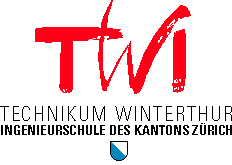
 |
Abteilung Elekrotechnik Praktische Diplomarbeiten |
|
| Energietechnik |
 |
|
||||||
| student: | Schafflützel Christian | ||||||
| Vollenweider Christian | |||||||
| dozent: | Schneider Martin Prof., Dipl. El.-Ing. ETH | ||||||
| abstract: | |||||||
|
The Coca Cola Amatil in Dietlikon is looking for solutions to redevelop their heating plant. They are discussing the implementation of a heating/power cogeneration. It was our task to study the technical and economical feasibility of a corresponding plant.In the first step, we collected all basic information to project the heating/power cogeneration and put them into a suitable form. Together with technical data we also considered financial and structural prerequisites.Based on these prerequisites, we designed four different plant variants. The comparison of the four designs showed that the single unit plant sized according to the thermal demand is the most suitable of all four. It is a natrual gas powered unit type heating/power cogeneration with a thermal output at 1063 kWth and an electrical output at 918 kWe. The temperature of the hot water is 120C (248F).In the next step, we estimated the investment of the new plant based on offers, which had been obtained before. The investment amounts to SFr. 1226000. The following economic appraisal results on a payback period of 9,2 years and specific costs for the generated heat of 1,08 Rp./kWh as well as specific costs for the generated electricitiy of 8,25 Rp./kWh.The results of our study show that the implementation of a heating/power cogeneration is a feasible option. The economical feasibility rises and falls with the changes of the prices for electricity. | |||||||
| student: | Bähler Marc | ||||||
| Thalmann Daniel | |||||||
| dozent: | Schneider Martin Prof., Dipl. El.-Ing. ETH | ||||||
| abstract: | |||||||
|
The Technikum Winterthur is in possession of a festpolymer fuel cell since a short time. The above mentioned generates current by an electrochemical process out of hydrogen and oxygen The main work of this diploma topic aimed for the fuel cell's commissioning, the extent of is characteristics so as the realization of a trial station. During a test trial, the fuel cell had been taken into operation and all relevant measures were coveraged in divers measurings. The maximum operating figures of the fuel cell resulted, due to manufacturers errors far below the given. Thanks to successful cooperation with the Paul Scherrer Institute manufacturing errors have been located with several testings. New membrans for the fuel cell were made and the cell in the test station was checked. With the steps taken into consideration, the amounts to 13 Watt by now, double the amount the manufacturer's specification. So as to present the fuel cell as a demonstration model and trial object at the Technikum Winterthur, we have realized a trial and start up station. Together with the trial station and the technical manual it is possible to take the fuel cell into operation and to test it even for unprofessionals. The data collection, the regulation of the fuel cell so as the display of measuring are being showed on an operator's visualizing software.
The given points are completely fulfilled. The fuel cell can be tested in the trial station without particular know how. From now on the trial station is at the Technikum students' disposal. | |||||||